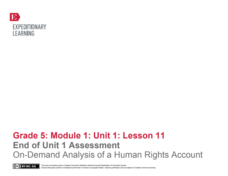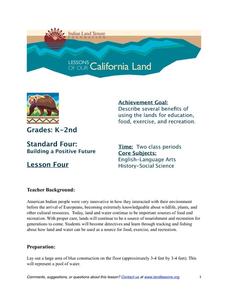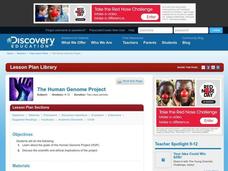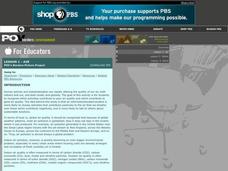Curated OER
How Resourceful Are You?
Learners investigate the concept of resources. They differentiate between natural, human, and capital resources. Prior to the lesson plan the students need to build background knowledge of goods, services, needs, and wants. They create a...
EngageNY
End of Unit 1 Assessment: On-Demand Analysis of a Human Rights Account
The last instructional activity in this unit about human rights consists of a final assessment. To demonstrate the skills your class has acquired throughout this unit, they will work with a new article entitled "From Kosovo to the United...
Population Connection
The Human-Made Landscape
Agriculture, deforestation, and urbanization. How have human's changed the planet and how might we mitigate the effects of human activity on the planet? To answer these questions class members research the changes in human land use from...
Population Connection
Meeting Human Needs
How to meet the needs of people around the globe—a question many ask. The fifth in a six-part series about human population and its effects on the globe, the eye-opening lesson includes discussion, a homework activity, and an in-class...
Channel Islands Film
Natural Resources, and Human Uses of Plants and Animals
As part of their study of the restoration projects on Santa Cruz Island, class members demonstrate their understanding of the connections among plant life, animals, and the actions of humans by crafting a model that reveals these...
Indian Land Tenure Foundation
Gifts from Land and Water
With a series of fun hands-on simulations, young children can learn about conservation and natural resources. Your learners become land detectives, discussing and investigating the gifts that the land and water provide them. They then...
Curated OER
Human Rights And Civil Rights
While he may not be as well known as civil rights activists such as Mahatma Gandhi, Dr. Martin Luther King, or Malcolm X, Ralph Bunche's contributions certainly made him a leader in the struggle for civil rights in the United States and...
Curated OER
Human Evolution: Biology, Bones
Learners will love a weeks worth of bone study. They use bones and characteristics of bones to explore the evolution of hominoids. Bones are compared, categorized, and considered. A great way to bring physical anthropology and material...
Creative Visions Foundation
Introduction to the Universal Declaration of Human Rights
Many people don't realize that all people on the planet are entitled to certain inalienable rights. Scholars discuss the subject with the first of four lessons in the Introduction to the Universal Declaration of Human Rights series....
Curated OER
Ages in Stages: An Exploration of the Life Cycle based on Erik Erikson's Eight Stages of Human Development
Examine Erikson's chart on the various stages one goes through growing up. Individually, they write a paper on whether or not they fit into those categories and how they are different today. In groups, for each stage they role play the...
Curated OER
The Human Body
A 'People Scavenge' activity gets learners out of their seat and in search for their peers, in order to discover differences among themselves. Prior to the hunt, students will complete a skit based on a portion of the Bible. The learners...
Consortium for Ocean Science Exploration and Engagement (COSEE)
One Ocean: It Matters!
Here is the first of four poignant lessons on how humans and oceans interact, even if people live far from the coast. This particular lesson also examines studies that are taking place in Antarctica of how climate change is affecting the...
EngageNY
Identifying Theme: Connecting Passages from Esperanza Rising to Human Rights
Even fictional characters have rights. Scholars read selected passages from Pam Muñoz Ryan's Esperanza Rising and consider which of the five categories from the Universal Declaration of Human Rights the text relates to. They glue each...
K20 LEARN
Ecosystems, Human Activity, And Interactions, Oh My!: Human/Environment Interaction
Word clouds about ecosystems hook learners into a lesson that explores Yellowstone wildlife. Young scientists create cause-and-effect relationships after examining data and recommend solutions to their observed problems. More data...
NOAA
Seafood and Human Health
Whether your young biologists realize it or not, humans play a significant role in marine ecosystems. To help them understand this fact children first create graphical representations that show homo sapiens' place in marine food chains,...
Curated OER
Human Sexuality Presentations
Students examine human health by researching the internet. In this human sexuality instructional activity, students utilize the web to locate a website which contains information about a certain sexual aspect. Students create a group...
Curated OER
Human Genome Project
Students examine the goals of the Human Genome Project. They research issues of the project such as scientific, potential and ethical implications of the project. In addition, they create a presentation to present their findings.
Curated OER
Human Anatomy- How Do We Move?
Young scholars explore the human anatomy. In this respiratory system instructional activity, students conduct an experiment to simulate the capacity of human lungs.
Curated OER
Human Anatomy -- How Do We Move?
Students create a model of the digestive system. In this human anatomy lesson the students examine features of the digestive system. The students perform an experiment.
University of Arkansas
Our Responsibilities
The fourth in a five-lesson unit examining human rights and personal responsibility asks class groups to investigate a current rights issue, and using the provided graphic organizer, summarize the issue, consider which rights are being...
NPR
Civil Rights of Japanese-American Internees
Prompted by a viewing of Emiko and Chizu Omori’s Rabbit in the Moon, a documentary about the internment of Japanese-Americans during World War II, high schoolers examine a series of documents, including the Bill of Rights and the UN’s...
Curated OER
P.O.V.'s Borders Picture Project: Lesson 1 - Air
Take photos of human activities that impact air quality. Collaborative groups present one of the photographs, identifying how the activity contributes to air quality and what can be done to minimize the impact. As one in a series of...
Curated OER
When Human Rights Are Wronged
Students explore the concept of human rights by examining the arresting of prominent Chinese dissidents who are members of the China Democratic Party. They develop and defend their own Bill of Human Rights and write a reflective essay.
Curated OER
African Artist El Anatsui as a Reflection of African Culture: Human Rights Issues and Activism Through Art
Students explore global issues through visual art analysis. In this African art lesson, students examine works by El Anatsui and discussing their human rights themes. Students then design lesson plans based on their findings.
Other popular searches
- Human Resources Management
- Human Resources Jeans
- Natural and Human Resources
- Pictures of Human Resources
- Business Human Resources
- Human Resources Department
- Human Resources 2nd Gradwe
- Human Resources 2nd Grad We
- Human Resources Lesson Plan
- Southwest Asia Human Resources

























